Opus sectile mosaic
Most mosaics are made of many small pieces (tesserae) which create a design. The overall effect depends on the colours, sizes, shapes, and arrangement of the pieces, and on the spaces between them (the interstices, or grouting joints). Opus sectile is a technique where, instead of having lots of individual tesserae, shapes in a picture are made from larger, specially cut pieces, usually of tile or stone. It is a practice that goes back to ancient Greece and Rome, and for an exploration of opus sectile in the ancient world I strongly recommend Bill Thayer's opus sectile page
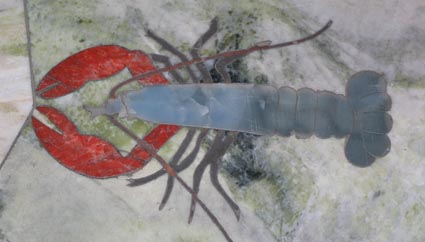 By cutting shapes from stone that contains patterns (such as
marble) a great deal of texture can be given to the image. Take
a look at this 20th century example set into the floor of the
Saint Andrew's chapel
in Westminster Cathedral. (Use the links on this page to see more
pictures of these examples.) The lobster is made up of a limited
number of pieces of very precisely cut stone that enrich it with
their own colours and mottled appearance. The skills and techniques
developed to produce this kind of work gave rise to the related
arts of pietre dure, marble inlay and cosmati pavements.
By cutting shapes from stone that contains patterns (such as
marble) a great deal of texture can be given to the image. Take
a look at this 20th century example set into the floor of the
Saint Andrew's chapel
in Westminster Cathedral. (Use the links on this page to see more
pictures of these examples.) The lobster is made up of a limited
number of pieces of very precisely cut stone that enrich it with
their own colours and mottled appearance. The skills and techniques
developed to produce this kind of work gave rise to the related
arts of pietre dure, marble inlay and cosmati pavements.
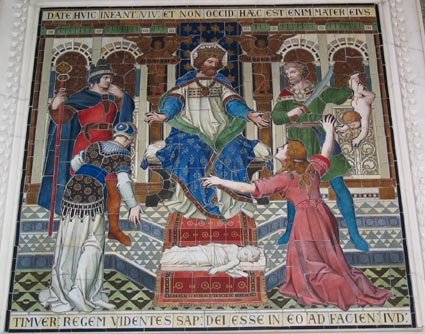
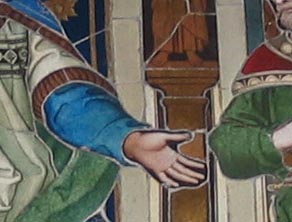 The name "opus sectile" translates as "cut work".
In the Victorian period the term began to be used for a different
style of mosaic treatment, as in the example below from Chapel
of St Gregory and St Augustine at Westminster Cathedral. Panels
like this were made by Powells (James Powell and Sons) using specially
made shaped glass tiles with a painted design on surface. The
way these fit together is shown in the detail below.
The name "opus sectile" translates as "cut work".
In the Victorian period the term began to be used for a different
style of mosaic treatment, as in the example below from Chapel
of St Gregory and St Augustine at Westminster Cathedral. Panels
like this were made by Powells (James Powell and Sons) using specially
made shaped glass tiles with a painted design on surface. The
way these fit together is shown in the detail below.
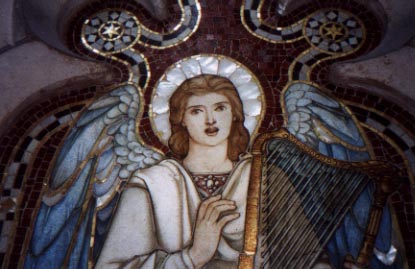 These panels had the durability of mosaic, but the painting
allowed more detail to be shown in a smaller space. This meant
that they could be used where they would be seen close to, or
where a life-like portrait was wanted of a particular person.
Traditional mosaic was often combined with opus sectile. In this
picture of an angel in Winchester
Cathedral, red, black, white and gold mosaic glass tiles have
been used for the background and border. There are also shaped
pieces of mother-of-pearl forming the angel's halo, in a manner
more like ancient opus sectile work.
These panels had the durability of mosaic, but the painting
allowed more detail to be shown in a smaller space. This meant
that they could be used where they would be seen close to, or
where a life-like portrait was wanted of a particular person.
Traditional mosaic was often combined with opus sectile. In this
picture of an angel in Winchester
Cathedral, red, black, white and gold mosaic glass tiles have
been used for the background and border. There are also shaped
pieces of mother-of-pearl forming the angel's halo, in a manner
more like ancient opus sectile work.
For more opus sectile, see the
Unitarian Church Bethnal
Green and St Peter's
Church, Dorchester
There's a place for opus sectile in modern mosaic too. In these examples a heart shaped from a single tile contrasts with the fragmented background, while the smile on the right is all the more bold for being formed of a single piece of ceramic.
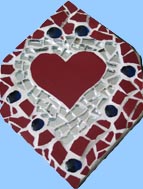
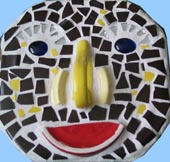
the joy of shards Mosaics Resource